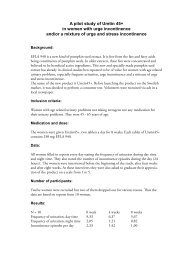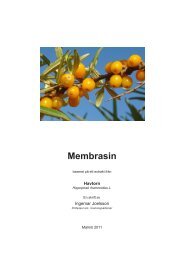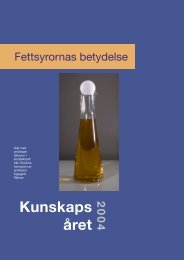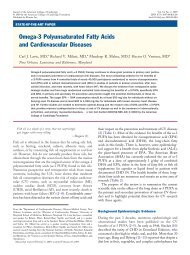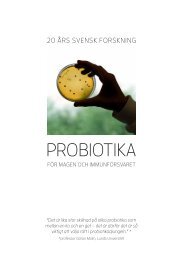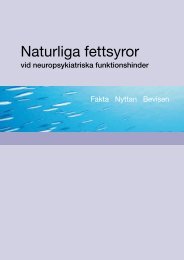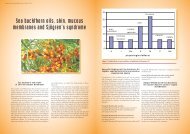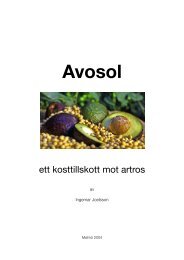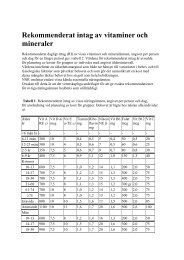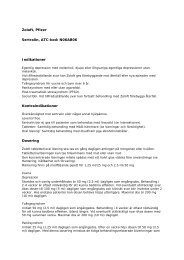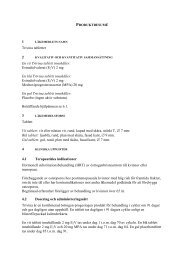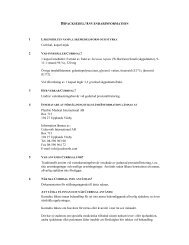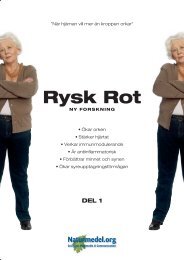Naturliga fettsyror under graviditet och - Scientific Communication AB
Naturliga fettsyror under graviditet och - Scientific Communication AB
Naturliga fettsyror under graviditet och - Scientific Communication AB
Create successful ePaper yourself
Turn your PDF publications into a flip-book with our unique Google optimized e-Paper software.
Referenser mumomega <br />
Referenser eye q <br />
1. Birch EE, Hoffman DR, Uauy R, Birch DG, Prestidge C: Visual acuity and the essentiality of<br />
docosahexenoic acid and arachidonic acid in the diet of term infants.<br />
Pediatr Res 1998; 44: 201 - 209.<br />
2. Birch EE, Hoffman DR, Castaneda YS, Fawcett SL, Birch DG, Uauy RD: A randomized<br />
controlled trial of long chain polyunsaturated fatty acid supplementation of formula in term infants<br />
after weaning at 6 wk of age.<br />
Am J Clin Nutr 2002; 75 (3): 570 - 580.<br />
3. Cheruku SR, Montgomery-Downs HE, Farkas SL, Thoman EB, Lammi-Keefe CJ: Higher<br />
maternal plasma docosahexaenoic acid during pregnancy is associated with more mature<br />
neonatal sleep-state patterning.<br />
Am J Clin Nutr 2002; 76 (3): 608 - 613.<br />
4. Forsyth JS, Willatts P, Agostini C, Bissenden J, Casaer P, Boehm G: Long chain<br />
polyunsaturated fatty acids supplementation in infant formula and blood pressure in later<br />
childhood: follow up of a randomised controlled trial.<br />
BMJ 2003; 3; 326 (7396): 953.<br />
5. Freeman MP, Hibbeln JR, Wisner KL, Brumbach BH, Watchman M, Gelenberg AJ:<br />
Randomized dose-ranging pilot rial of omega-3 fatty acids for postpartum depression.<br />
Acta Psychiatr Scand 2006; 113: 31 - 35.<br />
6. Ghebremeskel K, Crawford MA, Lowy C, Min Y, Thomas B, Golfetto I, Bitsanis D, Costeloe K:<br />
Arachidonic and docosahexaenoic acids are strongly associated in maternal and neonatal blood.<br />
Eur J Clin Nutr 2000; 54: 50 - 58.<br />
7. Gibson RA, Makrides M: The role of long chain polyunsaturated fatty acids (LCPUFA) in<br />
neonatal nutrition.<br />
Acta Paediatr 1998; 87: 1017 - 1022.<br />
8. Helland IB, Saugstad OD, Smith L, Saarem K, Solvoll K, Ganes T, Drevon CA: Similar effects on<br />
infants of n-3 and n-6 fatty acids supplementation to pregnant and lactating women.<br />
Pediatrics 2001; 108(5): E82.<br />
9. Helland IB, Smith L, Saarem K, Saugstad OD, Drevon CA: Maternal supplementation with<br />
very-long-chain n-3 fatty acids during pregnancy and lactation augments children’s IQ at 4<br />
years of age.<br />
Pediatrics 2003; 111 (1); e39 - 44.<br />
10. Hibbeln JR: Seafood consumption, the DHA content of mothers’ milk and prevalence rates of<br />
postpartum depression: a cross-national, ecological analysis.<br />
J Affective Disorders 2002; 69: 15 - 29.<br />
11. Hornstra G: Essential fatty acids in mothers and their neonates.<br />
Am J Clin Nutr 2000; 71 (5 Suppl): 1262 - 1269.<br />
12. Horrocks LA, Yeo YK: Health benefits of docosahexaenoic acid (DHA).<br />
Pharmacol Res 1999; 40: 211 - 25.<br />
13. Innis SM: Perinatal bi<strong>och</strong>emistry and physiology of long-chain polyunsaturated fatty acids.<br />
J Pediatr 2003; 143: 1 - 8.<br />
14. Jensen CL, Maude M, Anderson RE, Heird WC: Effect of docosahexaenoic acid<br />
supplementation of lactating women on the fatty acid composition of breast milk lipids and<br />
maternal and infant plasma phospholipids.<br />
Am J Clin Nutr 2000; 71: 292 - 99.<br />
1. Erik Lykke Mortensen EL, Michaelsen KF, Sanders SA, Reinisch JM. The association between<br />
duration of brestfeeding and adult intelligence. JAMA 2002; 287: 2365-71.<br />
2. Puri BK, Richardson AJ. Brain phospholipid metabolism in dyslexia assessed by magnetic<br />
resonance spectroscopy. Phospholipid Spectrum Disorder in Neurology and Psychiatry. 2003.<br />
Marius Press.<br />
3. Puri BK. Eicosapentaenoic Acid (EPA) rich essential Fatty Acid supplementation in Chronic<br />
Fatigue Syndrome associated with symptom remission and structural brain changes. Int.Clin.<br />
Practice. 2004 mars;58(3):297-9.<br />
4. Colquhoun I, Bunday S. A lack of essential fatty acids as a possible cause of hyperactivity in<br />
children. Medical Hypothesis 1981; 7: 673-9.<br />
5. Stevens LJ, Zentall SS, Deck JL, et al. Essential fatty acid metabolism in boys with attentiondeficit<br />
hyperactivity disorder. Am J Clin Nutr 1995; 62: 761-8.<br />
6. Baker SM. A bi<strong>och</strong>emical approach to the problem of dyslexia. J Learn Disabil 1985; 18:<br />
581-4.<br />
7. Peet M, Horrobin DF. A dose ranging study of the effects of ethyl eicosapentaeonate in patients<br />
with ongoing depression in spite of apparently adequate treatment with standard drugs. Arch Gen<br />
Psychiatry 2002; 59: 913-9.<br />
8. Puri BK, Richardson AJ, Horrobin DF, Easton T, Saeed N, Oatridge A, Hajnal JV, Bydder<br />
GM. Eicosapentaenoic acid treatment in schizophrenia associated with symptom remission,<br />
normalization of blood fatty acids, reduced neonatal membrane phospholipid turnover, and<br />
structural brain changes. Int J Clin Pract 2000; 54: 57-63.<br />
9. Burgess JR. Attention deficit hyperactivity disorder; observational and interventional studies.<br />
NIH workshop on omega-3 essential fatty acids in psychiatric disorder; National Institutes of<br />
Health, Bethesda, USA, 1998; Sept 2-3.<br />
10. Richardson AJ, Puri BK. A randomised, double blind placebo-controlled study of the effects<br />
of supplementation with highly unsaturated fatty acids on ADHD-related symptoms in children<br />
with specific learning difficulties. Prog Neuropsycho-pharm Biol Psychiat 2002; 26: 233-9.<br />
11. Voigt RG, Uorente AM, Berretta MC, Boutte C, Fraley JK, Jensen CL, Heird WC.<br />
Docosahexaenoic acid (DHA) supplementation does not improve the symptoms of attentiondeficit<br />
hyperactivity disorder (ADHD). Pediatr Res 1999; 45: 17A.<br />
12. Portwood, M. Developmental dyspraxia: the significance of diet. Special Magazine, March<br />
2002.<br />
13.Hibbeln JR. Seafood consumption, the DHA content of mothers milk and prevalence of postpartum<br />
depression; a cross-national ecological analysis. J Affect Dis 2001.<br />
14. Pawlosky RJ et al. Physiological compartmental analysis of alpha-linolenic acid metabolism in<br />
adult humans. Journ. of Lipid Research. 2001.42,1257-65.<br />
15. Richardson AJ. A randomized, controlled trial of dietary supplementation with fatty acids in<br />
children with developmental coordination disorder. Pediatrics.2005; 115(5):1360-1366.<br />
16. N Sinn et al. The effect of supplementation with polyunsaturated fatty acids and<br />
micronutrients on ADHD-related problems with attention and behaviour. Journ. of Developmental<br />
and Behaviour Pediatrics. In Press 2006.<br />
15. Jorgensen MH, Hernell O, Hughes E, Michaelsen KF: Is there a relation between<br />
docosahexaenoic acid concentration in mothers’ milk and visual development in term infants<br />
J Pediatr Gastroenterol Nutr 2001; 32 (3): 293 - 296.<br />
16. McGregor JA et al.: Clinical Update 2003; July: 1 - 12.<br />
17. Mischoulon D, Fava M: Docosahexanoic acid and omega-3 fatty acids in depression.<br />
Psychiatr Clin North Am 2000; 23 (4): 785 - 794.<br />
18. O’Connor DL, Hall R, Adamkin D, Auestad N et al.: Growth and Development in Preterm<br />
Infants Fed Long-Chain Polyunsaturated Fatty Acids: A Prospective, Randomized Controlled Trial.<br />
Pediatrics 2001; 108: 359 - 371.<br />
19. Olsen SF, Secher NJ, Tabor A, Weber T, Walker JJ, Gluud C: Randomised clinical trials of fish<br />
oil supplementation in high risk pregnancies. Fish Oil Trials In Pregnancy (FOTIP) Team.<br />
BJOG 2000; 107 (3): 382 - 395.<br />
20. Olsen SF, Secher NJ: Low consumption of seafood in early pregnancy as a risk factor for<br />
preterm delivery: prospective cohort study.<br />
BMJ 2002; 23;324 (7335): 447.<br />
21. Puri BK: The clinical advantages of cold-pressed non-raffinated evening primrose oil over<br />
refined preparations.<br />
Med Hypotheses 2004; 62 (1): 116 - 118.<br />
22. Slater A: Individual differences in infancy and later IQ.<br />
J Child Psychol Psyciatry 1995: 36 (1): 69 - 112.<br />
23. Smuts CM, Huang M, Mundy D, Plasse T, Major S, Carlsson SE: A randomized trial of<br />
docosahexaenoic acid supplementation during the third trimester of pregnancy.<br />
Obstet Gynecol 2003; 101 (3): 469 - 479.<br />
24. Willatts P, Forsyth JS, DiModugno MK, Varma S, Colvin M: Effect of long-chain<br />
polyunsaturated fatty acids in infant formula on problem solving at 10 months of age.<br />
Lancet 1998; 352 (9129): 688-691.<br />
25. Williams C, Birch EE, Emmett PM, Northstone K: Stereoacuity at age 3.5 y in children born<br />
full-term is associated with prenatal and postnatal dietary factors: a report from population-based<br />
cohort study.<br />
Am J Clin Nutr 2001; 73 (2): 316 - 22.<br />
Ytterligare information om fetter <strong>och</strong> <strong>fettsyror</strong>:<br />
• www.naturmedel.org<br />
• www.medref.se<br />
• www.equazen.com<br />
• www.durhamtrial.org




